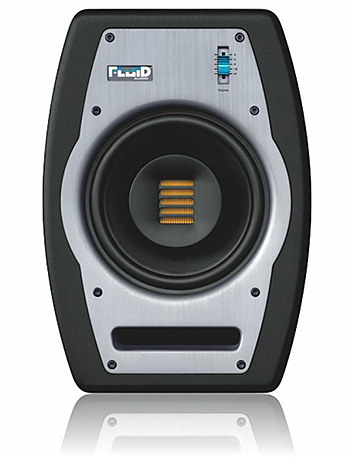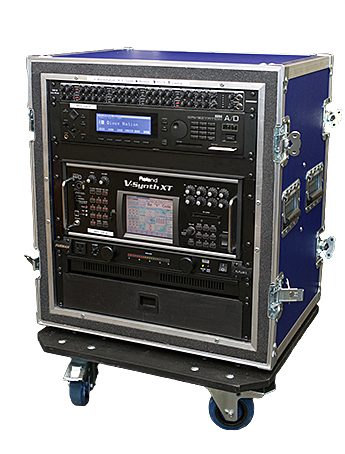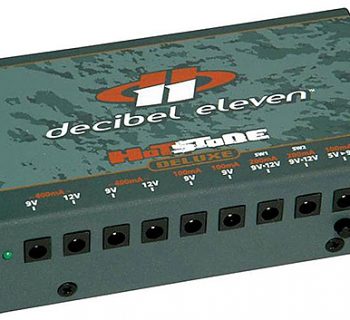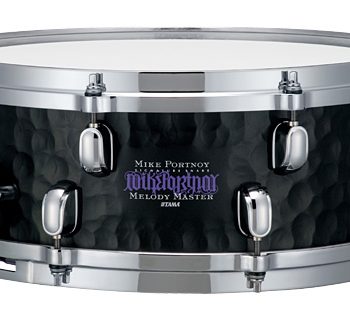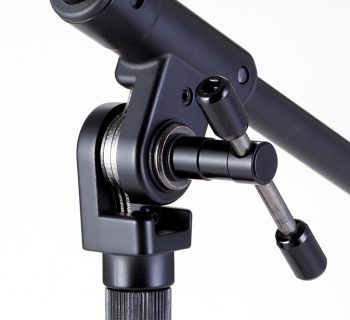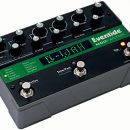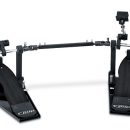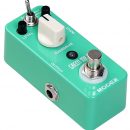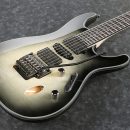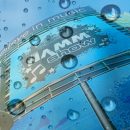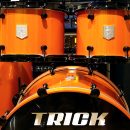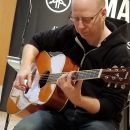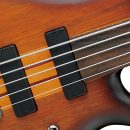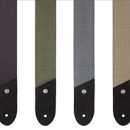 This is a fantastic time to be a keyboard player. Not because of advances in digital technology, but because of the resurgence of analog technology presented in a modern context. Dave Smith has been masterful at this, developing so many classic analog and digital synths over the decades that his resume reads like a lesson in synthesizer history.
This is a fantastic time to be a keyboard player. Not because of advances in digital technology, but because of the resurgence of analog technology presented in a modern context. Dave Smith has been masterful at this, developing so many classic analog and digital synths over the decades that his resume reads like a lesson in synthesizer history.
Another analog mastermind was Tom Oberheim, who gave us the SEM, OB-8 and OB-Xa synthesizers (among others). In the late 1970’s and 1980’s these two gentlemen were competitors as much as contemporaries, so who would have thought that in 2016 these two would team up? Broken crystal ball aside, the resulting collaboration, the OB-6, is sure to please fans of either one of these legendary synth designers.
The OB-6 is a six-voice synth based on Oberheim’s SEM four and eight voice synths, and then adds modern features such as effects, a sequencer, and an arpeggiator, with some features derivative of DSI’s own Prophet-6. Though the effects are digital (and fantastic), they can be bypassed, allowing for a fully analog signal path. The OB-6 also incorporates X-Mod, which enables interesting sound creation by allowing two modulation sources to be routed to numerous destinations. Armed with 500 presets (with room for an additional 500 user sounds) and an easy to use control panel, the OB-6 simultaneously allows complex editing as well as instant gratification. We love this polysynth, and suspect you will, too.
Features
The six-voice, OB-6 sound engine features two voltage-controlled oscillators (plus a sub-oscillator) per voice with continuously variable waveshapes (sawtooth and variable-width pulse, plus a triangle wave on Oscillator 2). A big part of the revered “Oberheim sound” was Tom’s filter, and it is present on the OB-6. The classic Oberheim two-pole, 12dB/octave, state-variable, resonant filter provides low-pass, high-pass, band-pass, and notch functionality. The amplifiers are voltage-controlled, which complete an all-analog signal path (unless you opt to run the signal through the bypassable digital effects).
An interesting feature is the oscillator detune feature, which allows for increased tuning instability. The instability and imperfections of older electronics were an important part of classic synth sounds, and you can dial some of that quirkiness in if desired. Note that this is independent of the Detune parameter on VCO 2, which is specifically a fine-tune control with a range covering a quarter tone up/down (centered at 12:00). Steps are in cents (50 cents = ½ semitone).
The effects include reverbs, delays (standard and emulated BBD), chorus, flangers, as well as Tom Oberheim’s revered phase shifter and ring modulator. These are digital (24 bit/48kHz resolution), but are bypassable if desired. You may use two at a time. Of note, the OB-6 also includes analog distortion.
The OB-6 incorporates something called X-Mod, which is the OB-6 system of creating sounds by mapping modulation sources and destinations. Modulation sources are a filter envelope and Oscillator 2, both with bi-polar control. Destinations include Oscillator 1 frequency, Oscillator 1 shape, Oscillator 1 pulse width, filter cutoff, and filter mode.
The OB-6 also has a polyphonic step sequencer, which lets you program up to sixty-four steps and up to six notes per step. You can create sequences polyphonically, with rests and tied notes, and sync to an external MIDI clock.
The OB-6’s arpeggiator can be synced to external MIDI clock as well, and there are selectable note values: 16th note, 8th note triplet, 8th note, dotted 8th note, and quarter note. You can choose a one-, two-, or three-octave range, as well as the expected up, down, up/down, random, and assign modes.
Unison mode features configurable voice count (1-6 voices), allowing for very thick sounds, and there’s a cool chord memory function that enables the OB-6 to memorize and store the notes of a chord. Single notes played from the keyboard will trigger the stored chord, transposing it as you play up or down the keyboard.
So... let’s talk about that control panel!
One thing you’ll notice is what isn’t there: NO LCD screen! But have no fear—with one-knob-per-function controls, it really doesn’t matter. There are six, three-letter LEDs on the panel (i.e., for patch numbers or abbreviating effects being used), and there are so many well-labelled knobs it wasn’t a big deal to navigate once we sat with the OB-6 for a little bit.
The only thing we found disappointing regarding the absence of a display was that there are no patch names—only numbers. Of course back in the day, there was no patch memory at all, and then subsequently just a numbering system for the limited patch memory on classic synths. Now, though, you have 500 permanent factory presets plus another 500 user sound locations to store patches, so expect to be making your own patch lists on your laptop or tablet.
The left side of the control panel has the modulation section. Here you’ll find controls for aftertouch, the X-Mod section, and the LFO section, which allows you to select five wave shapes: sine, sawtooth, reverse sawtooth, square, and random. Mark Wilcox at DSI shared this awesome tip with us: There’s actually a sixth “hidden” LFO wave shape: noise. To use it, select “Random” and crank up the LFO rate to its maximum.
Below the modulation section is an octave selector, which is certainly helpful because the OB-6 retains the same, limited, 49-key design as the awesome Prophet-6. It has semi-weighted keys, and velocity and channel aftertouch.
The middle panel has multiple sections. You’ll find the arpeggiator section, sequencer play/record buttons, and tempo and clock controls. Lower in the middle section are the VCO 1 and 2 sections, allowing frequency and detune choices. Moving right, there is the mixer section which allows you to control the Oscillator 1 amount, Oscillator 1 sub-octave amount, Oscillator 2 amount, and white noise amount. Nearby is the filter section, with controls for frequency and resonance.
On the far right is the effect section, and well as the envelope section. The effect section has three-character LEDs to identify what effect you are using, as opposed to silkscreened lettering on the panel itself. In the envelope section you will find the expected ADSR controls. Finally, to the far right is the output section, where you will find the master volume knob.
An interesting button underneath the output section is the Manual button. Pressing the Manual button immediately makes all the knob positions live, ignoring whatever preset you were previously just on, so what you see is truly what you get. Nice!
Right above the keyboard itself are a row of buttons, as opposed to the knobs found everywhere else. These are multipurpose. It is here you can select the patch and bank of sound(s) you want, but it is also where you can program the sequencer, one step at a time. Nearby are portamento and detuning controls, and further left are Dave’s signature red-backlit pitch and mod wheels.
Finally, the ports out back include a pair of stereo/mono, ¼” audio outputs, ¼” headphone jack, MIDI In/Out/Thru ports, USB for bidirectional MIDI communication, filter cutoff expression pedal input, volume expression pedal input, sustain footswitch input, and a sequencer start/stop footswitch input.
Usability
The OB-6 delivers a wonderful blend of old and new. Just like our beloved, classic polysynths from the Eighties, there were no deep menus and no LCD screens. Just knobs, sliders, buttons, and a two-character LED. If you like a given patch, great; but if not, grab a slider, turn a knob, and change the sound! It was immediate and very easy to use.
We used to own a Oberheim OB-Xa, and the OB-6 definitely captures the spirit of its lineage. Virtually every function has a dedicated knob to turn and adjust to your heart’s content, though we would have preferred the inclusion of some sliders for some of the controls as well.
Though there is nostalgia seeing the blue stripes across the OB-6 that marked the original Oberheim synths, the additional silkscreen labels tell you what everything is, and the panel is laid out in an organized, “this makes sense” kind of way. However, on a poorly lit stage, we would have some trouble reading some of the labels as there is no backlighting behind them.
You could argue that since the OB-6’s modulation is limited to what is printed on the panel, you don’t have as many choices as other synths, including DSI’s own Prophet 8 or Prophet 12. But we think that’s the beauty of the OB-6. The immediacy of physical, hardware control will get you up and running fast, and in the OB-6’s case, partially because there are fewer paths to choose from.
Those familiar with DSI synths will likely notice the OB-6 has quite a bit of similarity to DSI’s own Prophet 6. While the OB-6 has a similar footprint, as well as a similar voice architecture to the Prophet-6—two discrete VCOs per voice plus a sub oscillator, there are some significant differences. The OB-6 oscillators were taken from Tom Oberheim's famed SEM design. However, the triangle waveform available on the OB-6 did not exist on the SEM (and is indeed borrowed from the Prophet-6). Another difference is that the sub oscillator on the OB-6 is a square wave rather than the triangle found on the Prophet-6.
Perhaps the biggest notable difference in the OB-6 from the Prophet-6 is the filter architecture. The Prophet-6 has a four-pole low-pass filter and a two-pole high-pass filter operating independently of one another, whereas the OB-6 follows the Oberheim architecture of a single, two-pole, state-variable filter. This filter can slide seamlessly between different modes with the Filter Mode knob. The OB-6's filter mode can be modulated with the LFO, keyboard aftertouch or the X-Mod section, which allows you to modulate with the filter envelope or the frequency of oscillator two. We didn’t realize it initially, but after some investigative reading, we learned that this filter design is borrowed from Dave Smith's monophonic/paraphonic Pro-2 synth, which itself was borrowed from the Oberheim SEM. We loved the P2’s gritty sound, and getting some of that raw P2 character in a true polysynth is a nice bonus. (You can see our reviews of many other Dave Smith synths here).
We found the step sequencer very easy to use, and it was actually quite fun to program, in a large part, due to dedicated buttons for programming each step. The chord memory function is a novel concept, and it also provided some great inspiration for musical ideas as it gave us an interesting new way to manipulate chords in real time.
Sound
At the end of the day, regardless of new or old technology, it comes down to how the damn thing sounds. And we really like the sound of the OB-6. While not quite as gritty as Dave Smith’s Pro 2, it is more raw than the DSI Prophet 12—and in a very good way. One of the hallmarks of DSI synths is their musicality, and to their credit, the quality of the presets themselves. Many are inspiring enough to make you fire up your DAW to start recording a new song immediately, which is one of the highest compliments we can give.
More specifically, there are great pads, interesting arpeggiated sequences, and thick basses. We don’t mind that the effects are digital as they add nicely (when desired) to the overall sound. Unlike some classic polysynths, though, the OB-6 doesn’t need to rely on a chorus effect to sound full. The dedicated controls make instant gratification a reality, and make it easy to manipulate sounds live while playing.
It’s easy to assemble your own collection of favorite sounds thanks to the generous memory for up to 500 of your favorite patches, but we really wish patches could have names. By default, the 500 memory slots contain a duplicate of the factory preset banks, so you can overwrite these to your heart’s content and always go back to the factory banks if you want to access an original sound. Perhaps a future editor/librarian will make patch finding/grouping easier, as opposed to “patch 69”, for example.
You may be wondering, “Does it really sound like an Oberheim?” We would have to say, absolutely! The OB-6 tone falls far more into the Oberheim tone camp than any other DSI synths. Going through the patches, there were a few that were close to the classic OB-Xa “Jump” patch (which we couldn’t resist tweaking until they were even closer), and we stumbled upon a patch that was a dead ringer for the opening synth part from Bon Jovi’s “Runaway” (which, if you look at the video, was also performed on an OB-Xa). Other presets were clearly reminiscent of Prince’s work, particularly from the 1999 and Purple Rain albums, which makes sense given that Prince was known to use the entire OB synth series throughout his career.
Make no mistake though. This synth is way more flexible and powerful than simply serving as the anchor in your ‘80s tribute keyboard rig. That’s the great thing about the OB-6: it can do the classic stuff, but is equipped to deliver relevant sounds for today and beyond. Even better, compared to our previously owned OB-xa, it’s more than twenty pounds lighter and always stays in tune (unless, of course, you purposely choose for it not to)!
Once again, Dave (and this time with Tom) has delivered a polysynth that yields a distinctly different flavor than DSI’s other creations. I guess we’ll just have to clear some more space in the studio.
Video courtesy of DSI and INHALT
Documentation and Product Support
The OB-6 includes a printed manual (as do all DSI products), which we appreciate! It also includes a quick start pamphlet to get you up and running fast, including explanations for how to use the very fun chord function.
On the website, there are several tutorial videos as well. There’s even a video of Dave and Tom meeting in a bar, coming up with the idea for the OB-6 on a napkin. Not sure we really believe that one, but it sure is entertaining.
Price
The OB-6 (MSRP $3,299) sells for around $3,000, the same price as many other modern analog and analog/digital-hybird synths. While you can make the argument that $3,000 for only 49 keys is questionable, the OB-6 more than delivers in the sound and ease-of-use departments. Speaking from experience, the OB-Xa we previously owned was a monster in every way: in sound, in weight, and in cost of maintenance. To get some of the best parts of that Oberheim goodness in a modern polysnth that features Dave Smith’s fantastic design sensibilities, this is a synth you’ll want to check out. Despite the familiar form factor, it is remarkably different from the other DSI synths.
Contact Information
Dave Smith Instruments
www.davesmithinstruments.com
Overall Rating - Product Summary
| Category | Value | Rating |
| Features | 20% | |
| Usability | 25% | |
| Sound | 25% | |
| Documentation & Support | 10% | |
| Price | 20% | |
|
|
||
| OVERALL RATING = 3.7 Stars, which earns it a WIHO! 3.6 stars or better: Outstanding, WIHO Award 3 stars or better: Worth considering 2 stars or better: Suited to specific needs 1 star or less: Not recommended |
||


